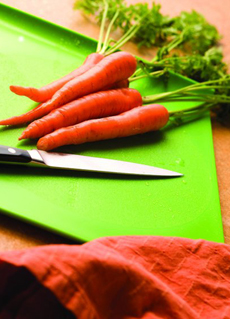TIP OF THE DAY: Use Those Carrot Peelings To Make Carrot Oil & Carrot Stock
|
Says chef Johnny Gnall: “One of the most important roles a chef can play in a restaurant is that of dumpster diver. Sometimes the scraps you throw away are potential ingredients in other foods. Making use of of them, instead of throwing them into the compost pile, can mean added revenue—as well as some tasty results. ”A perfect example of such trash-into-treasure scraps is carrot peelings. Though most people would consider them to be inedible and useless, there are actually different things you can do with them that create nice culinary accents.” Here are Chef Johnny’s tips to turn carrot peelings into something special. MAKE CARROT OIL Carrot oil, with its brilliant orange color, is a lovely addition to many a dish. Drizzle it to finish soups and entrée plates, use it in vinaigrettes and otherwise add a gourmet accent. Depending on the sweetness of the carrots, the oil will deliver sweetness and carrot essence that add a little je nais se quoi to any meal. You can also use it to punch up the carrot flavor in your favorite carrot recipe. |
 After you peel the carrots, don’t toss the peelings! The cutting board is made from recycled products such as yogurt containers, by PreserveProducts.com. |
|
|
The color of your carrots and their peelings will have a large effect on the oil’s color and clarity. Look for bright orange carrots, or the red or purple varietals. They are great specimens with which to infuse your oil. Preparation 1. Clean. Clean carrots before peeling (we scrub the skins with a vegetable brush). Take at least one packed cup of carrot peelings and plunge them into ice cold water; then remove and leave them to dry on a paper towel. One time-saving trick: Use a hair dryer to dry the peels! Thorough drying is important, as any excess water left on the peels will create beads in the oil. 2. Sautée. Place the dry carrot peelings in a sautée pan and add at least enough grapeseed oil to cover them: a volume ratio of one cup of oil per cup of peelings. Turn the heat to low and keep an eye on it. At the beginning, you may have to play with the heat level until you get it just right: You want to see tiny bubbles form on and around the peelings, but you don’t want the oil to sizzle and pop. The goal is not to fry the peelings, but to soak them in the oil. 3. Cook. Once you have the heat right, leave the oil and peelings to “cook” for about 15 minutes; then turn off the heat and let the peelings steep for an hour or longer. Then strain the oil into a bottle, discarding the peelings. MAKE CARROT STOCK Another easy and useful trick to get some magic out of carrot peelings is to make carrot stock. For this application, you will want to have a lot more peelings on hand; so unless you happen to have just made several pounds’ worth of carrot soup, collect the peelings over time in an airtight plastic bag or storage container and stash them in the freezer. Once you have at least a couple of quarts, you’re good to go. Preparation 1. Combine. In a large stockpot, combine carrot peelings, a couple of bay leaves, 10 peppercorns, a quartered onion and a sprig of thyme. Fill the pot the rest of the way with water. Bring everything to a boil, then lower the heat, uncovered, to a low simmer, and allow the stock to reduce. 2. Reduce. The more you reduce your stock, the more concentrated its flavor will be; so let at least a third of the liquid evaporate. When it’s done, strain everything out. The liquid that remains is an instant sweetener. 3. Use. If you are making a dish that would benefit from a nice, mild sweetness in its early stages, this stock is a terrific option. It will help create a more well-rounded dish than water would in its place, and it is a vegan and vegetarian-friendly base for soups, sauces and more. The carrot flavor is not strong, but its round, soft sweetness is what you want to utilize to balance any dish. These two ideas are just the beginning of what’s possible when you “repurpose” what you would have thrown out. Your fruit and vegetable scraps are keeping some valuable secrets. We’ll discuss more in future tips. |
||


